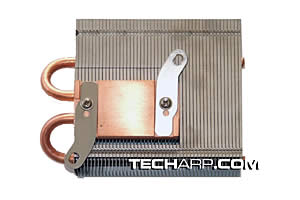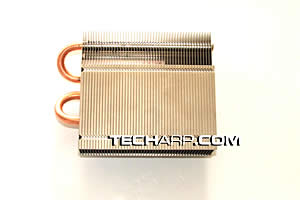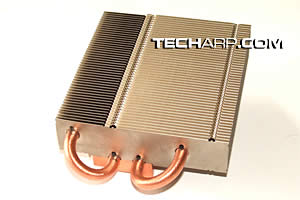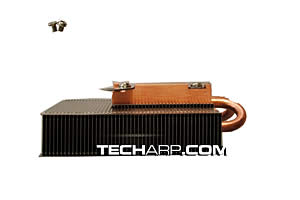Sytrin VF1 (Continued)
Design & Build Quality
One thing that bothered me right from the start was that out of the two coolers I purchased, one had an awful base finish. It had marks on it and was visibly uneven. The base wasn't even flat - it was actually convex, with the centre higher than the sides.
The other cooler was relatively flat and smooth, although still nowhere near the standard of the other coolers in this review. However, it was still, by far, the better of the two and it will be the one I will be using for evaluation.
 |
The VF1 fin construction is unique in that the entire middle portion is closed to ensure that air flows through the entire heatsink and out the other side. This is because the VF1 relies on airflow from the side of the heatsink and not from the top or bottom like other coolers in this review.
A long screw goes into a hole on each wing. These screws are meant to go through the graphics card's mounting holes to the other side, where they are fastened by a washer and a spring-loaded screw.
Sounds simple on paper, but in reality this was not the case. After mounting the cooler, I held it up to the light and was quite horrified to find that there was absolutely no contact between the heatsink and the GPU.
I removed the cooler and realised that the heads of the screws supplied were too high, and were preventing a tight mount. As you can see from the picture below, a thick screw head can prevent the proper mounting of the heatsink base.
Fortunately, it was easy to correct the problem. All I had to do was replace the original screws with ones that had a flatter head. With the new screws in place, it was now possible to properly mount the heatsink.
It's bad enough for a heatsink to have an uneven base. It's simply unacceptable for a cooler not to be mounted properly using the supplied hardware. I was about ready to give up and throw this garbage away, but the curiosity incited by all the rave reviews forced me to continue.
The full VF1 Plus version comes with a crossblow fan which directs air through the heatsink. The regular version utilises a regular axial fan (fan not included) affixed next to the graphics card, directing the air flow at the heatsink.
Sytrin claims that any standard 80mm, 92mm or 120mm fans can be fitted onto the VF1. However, the fan will be mounted at an angle, and I do not believe that a 120mm axial fan will be able to fit into a standard ATX case with the side panel on. So, I opted to use a 92x25mm Delta fan for the test.
Author's note : At the time of writing, Sytrin is said to have a new fan bracket in the works meant for use with 120mm fans, and can be positioned to blow at two Sytrin heatsinks in close proximity, e.g. in an SLI or CrossFire configuration. Whether this improves the fan mounting, and/or changes the cooler's installation remains to be seen.
Sytrin provided two plastic rivets which are supposed to hold
the fan in place on the bracket. But wouldn't you know it, the rivets
don't work. ![]()
After about 5 minutes of struggling with the rivets, I realised that there was no hope of them ever securing the fan. So, I used a couple of standard self-tapping fan mounting screws instead. The screw holes on the bracket were a little too small but by this time I was feeling quite frustrated so I just forced them in.
Naturally, the bracket isn't compatible with the tool-less clips
meant to secure the expansion cards in my case, so that resulted in another
5 minutes of struggling. Those tool-less clips really spoil you, I can
tell you that. ![]()
With everything finally in place, we can now introduce you to the final contender from a perennial Tech ARP favourite - Thermalright.
<<< Introduction, Zalman VF900 Cu, Sytrin VF1, The Package : Previous Page | Next Page : Thermalright V1, Stock Cooler >>>







 Add to Reddit
Add to Reddit




